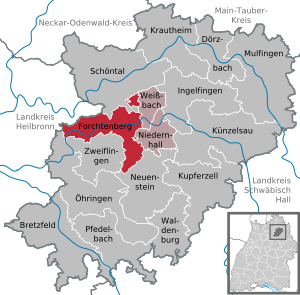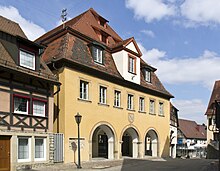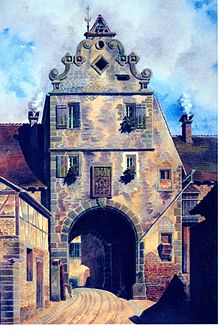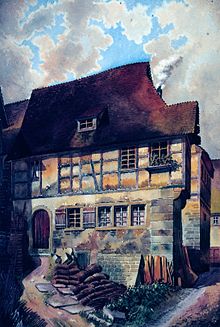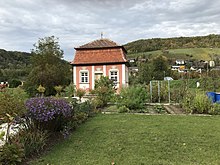Forchtenberg
| coat of arms | Germany map | |
|---|---|---|

|
Coordinates: 49 ° 17 ' N , 9 ° 34' E |
|
| Basic data | ||
| State : | Baden-Württemberg | |
| Administrative region : | Stuttgart | |
| County : | Hohenlohe district | |
| Local government association: | " Middle Kocher Valley " | |
| Height : | 223 m above sea level NHN | |
| Area : | 38.08 km 2 | |
| Residents: | 5057 (December 31, 2018) | |
| Population density : | 133 inhabitants per km 2 | |
| Postcodes : | 74670, 74249, 74632 | |
| Primaries : | 07947, 07948, 07942, 07943 | |
| License plate : | KÜN, EAR | |
| Community key : | 08 1 26 028 | |
| LOCODE : | DE FTB | |
| City structure: | 5 districts | |
City administration address : |
Hauptstrasse 14 74670 Forchtenberg |
|
| Website : | ||
| Mayor : | Michael Foss | |
| Location of the city of Forchtenberg in the Hohenlohe district | ||
Forchtenberg is a town in the Hohenlohe district in the Franconian north-east of Baden-Württemberg . It belongs to the Heilbronn-Franconia region (until May 20, 2003 Franconia region ). Today's town of Forchtenberg was established in 1971/1972 through the incorporation and amalgamation of the towns of Forchtenberg and Sindringen and the communities of Ernsbach , Muthof and Wohlmuthausen .
geography
Geographical location
The town of Forchtenberg is located at the confluence of the copper in the Kocher . The old town stands on the left bank of the Kocher on the slope of a mountain spur, the back of which bears the Forchtenberg ruins. To the north of the old town, on the opposite bank, lies the Neuwülfingen housing estate.
The municipal area extends from the suburb of the central Forchtenberg as a wide strip downstream on both sides of the Kocher valley to below Sindringen in the west. Likewise in the narrower wedge of the Wohlmuthausen suburbs southwards along the lower Kupfertal and across the middle Sall valley to the edge of the Hirschbach valley .
A smaller community exclave lies north of Forchtenberg itself on the ridge in front of the Jagsttal .
City structure
The city of Forchtenberg consists of the following parts:
- Ernsbach with Ernsbach itself and the Waldberg residential area
- Forchtenberg with Forchtenberg itself, the Rauhbusch-Hof homestead and the Neu-Wülfingen residential area
- Muthof with Muthof itself and the hamlets of Büschelhof and Schleierhof; Exclave in the north of the rest of the city
- Sindringen with Sindringen itself, the Holzweiler Hof and Neuzweiflingen (Trautenhof) farms and the Schießhof and Ziegelhütte residential areas
- Wohlmuthausen with Wohlmuthausen itself, the hamlets of Hohensall, Metzdorf, Orbachshof and Schwarzenweiler as well as the Haberhof homestead
Division of space

According to data from the State Statistical Office , as of 2014.
history
Until the 19th century
Forchtenberg goes back to the town of Wülfingen , which was once located to the north-west of the town and was inhabited in prehistory and was first mentioned in 771. Wülfingen was the seat of a Kochergau count in 1042 and passed to the Lords of Dürn in 1210 , who built a castle on the mountain spur southeast of Wülfingen. The name Forchtenberg is derived from the description "in front of the mountain". The castle Forchtenberg was completed under Konrad von Dürn in 1234th Presumably at the same time, the fortified town of Forchtenberg was laid out at the foot of the castle, which was first mentioned in a document in 1298 and in whose favor Wülfingen was given up.
When the Counts of Dürn died out, the castle and town fell to the Lords of Hohenlohe-Weikersheim in the early 14th century . The castle became the residence of Ulrich, the son of Kraft III, who, however, had to pledge his property in 1399. The widow Albrecht I released the pledge in 1438 and received the castle as a widow's seat. The castle was later the seat of a Hohenlohe bailiff and was largely destroyed in the Thirty Years' War .
As a result of the Reichsdeputationshauptschluss , the Hohenlohe Lands, which belonged to the Franconian Empire between 1500 and 1806 , fell to the Kingdom of Württemberg in 1806 . Forchtenberg was assigned to the Oberamt Öhringen (from 1938 district Öhringen ).
20th century
On June 22, 1924, the village received a rail connection to Waldenburg with the Kochertalbahn , which led to an economic boom.
In March 1945 a Wehrmacht command blew up both the copper and the Kocher bridge, despite protests from the residents. In April, American artillery fire and air strikes destroyed at least a third of the buildings in three days. Then American troops marched through Forchtenberg on April 11, 1945 against little resistance, which ended the Second World War in Forchtenberg. Former forced laborers ransacked the city in the days that followed. A “Stalinist takeover” at the end of April was put to an end on June 5, 1945 by the American military government by arresting those responsible.
Since Forchtenberg had become part of the American zone of occupation after the Second World War , the city had belonged to the newly founded state of Württemberg-Baden since 1945 , which was merged into the current state of Baden-Württemberg in 1952.
With the district reform in Baden-Württemberg , the city became part of the new Hohenlohe district on January 1, 1973 . 1981 the passenger traffic on the Kochertalbahn was stopped.
Community reform
On December 1, 1971, Wohlmuthausen was incorporated into Forchtenberg. On January 1, 1972, the cities of Forchtenberg and Sindringen merged with the communities of Ernsbach and Muthof to form the new city of Forchtenberg.
Coats of arms of the earlier municipalities
 Wohlmuthausen |
 Sindringen |
 Ernsbach |
|---|
politics
mayor
- Around 1810 mayor Haag
- Around 1820–1837 from Olnhausen
- 1837–1847 Schall (notary)
- 1847–1860 Ludwig Blanck
- 1860–1872 Walther (notary)
- 1872–1876 Karl Krauss
- 1876-1892 Karl Böhringer
- 1892–1900 Paul Hüzel
- 1900–1906 Christian Wirth
- 1906–1919 Hermann Hörer
- 1919–1930 Robert Scholl
- 1930–1933 Friedrich Kramer
- 1933–1936 Eugen Maurer
- 1936–1945 Adolf Hebeiß (from 1942 to 1945 represented on account of military service by official administrator Richard Leitlein)
- 1946–1948 Wilhelm Wolf
- 1948–1948 Friedrich Haag
- 1948–1966 Adolf Hebeiß
- 1966–2004 Martin Tuffentsammer
- 2004–2016 Uwe Gysin
- from May 2016: Michael Foss
Municipal council
In Forchtenberg, the municipal council is elected using the spurious selection of a part of town. The number of local councils can change due to overhang mandates . The municipal council in Forchtenberg has 19 members after the last election. The local elections on May 25, 2014 led to the following official final result. The turnout was 51.18%. The municipal council consists of the elected voluntary councilors and the mayor as chairman. The mayor is entitled to vote in the municipal council.
| Independent electoral association | 51.62% | 10 seats |
| Free electoral association | 42.94% | 8 seats |
| Citizen's Voice | 5.44% | 1 seat |
badges and flags
The blazon of the Forchtenberg coat of arms reads: In red the standing, gold nimbed and silver armored Archangel Michael piercing the throat of the silver lindworm with a gold cross spear. The city flag is white and red.
After its re-establishment in 1972, the city of Forchtenberg essentially took up the old Forchtenberg coat of arms, which has been documented in Siegeln since 1516. The spear of Archangel Michael was changed into a golden cross spear in memory of the golden cross in the former coat of arms of the Sindringen district . The colors red and white are the colors of the coat of arms of Hohenlohe as well as of Weinsberg and Schöntal and thus have a reference to all former communities that were absorbed in the city of Forchtenberg. The coat of arms and flag were awarded to the city on June 7, 1978 by the district office of the Hohenlohe district.
Culture and sights
Buildings
Forchtenbergs medieval old town has numerous half-timbered buildings and a partially preserved or rebuilt walls with battlements and several towers or gatehouses, including the city open towards Civic Tower and the Würzburgtor in the north and the Diebsturm , a tower of the city wall to the south. In the historic city center , which is a listed building as a whole , are u. a. the town church built around 1300 and renovated in 1587 , the town hall (birthplace of Sophie Scholl), the bakery with the Forchtenberg clock tower and the Kernhaus built around 1470 , the home of the Kern family of artists, who died out in 1691. The former gypsum mine is located under the city center .
Earlier tower clock of the bakery
The Forchtenberg ruin rises above the old town . The former castle was built under Konrad von Dürn until 1234 , then it was the residence and widow's seat of the Lords of Hohenlohe-Weikersheim and later the seat of Hohenlohe officials. The castle was largely destroyed in the Thirty Years' War, but the large vaulted cellar that had been preserved was expanded in the second half of the 17th century and continued to be used to store the wine tithing. The system was then privately owned from 1850 and deteriorated. After the first private conservation efforts from the 1930s onwards, the city of Forchtenberg acquired the facility in 1989, has carried out conservation measures there since then and uses the site for events.
North-west of Forchtenberg, on the opposite side of the Kocher, is the historic Michaelskirche in the cemetery , which was once the church of the abandoned village of Wülfingen and the original church for the surrounding Kocher valley. A predecessor of today's cemetery church, which contains frescoes from the 14th century inside, may have existed long before Wülfingen was first mentioned in 779. The baroque tea house is also located on the northern bank of the Kocher .
The entire old town, the ruins and the cemetery church have been placed under monument protection. The Hans-and-Sophie-Scholl-Path leads to numerous sights and places that are connected to the Scholl siblings.
Memorials
At the City Hall main road 14 since 1969 a memorial plaque to the Christian fighters against the Nazi dictatorship Hans and Sophie Scholl , who as members of the " White Rose " in 1943 in Munich were killed.
Regular events
Every May there is a large pottery market in the Sindringen district with suppliers from all over Europe. The Forchtenberg castle ruins are used every year in mid-July for the Christian open-air festival Rock in the Ruins . An open-air cinema has been held here every year since 2005 at the end of July / beginning of August, organized by the FoKus (Forchtenberger Kulturszene) association founded in January 2005 together with a cinema operator from Künzelsau. Every year on the first weekend in Advent there is also a Christmas market in the medieval Forchtenberg old town.
The public education center of the city of Forchtenberg, founded in 1948, offers around ten events with a wide range every year; In addition to music concerts and slide shows, there are also contributions on history, health, literature and interesting facts from all over the world. The Sindringen cultural initiative (KIS) organizes jazz and blues evenings, cabaret and an annual Irish evening.
Economy and Infrastructure
Forchtenberg is a wine-growing place whose vineyards belong to the major Kocherberg site in the Kocher-Jagst-Tauber area.
traffic

Forchtenberg is the most important traffic connection in east-west direction from the Kochertalstraße (L 1045). There are also road connections between the districts and the neighboring communities. The city is connected to the medium-sized centers of Öhringen and Künzelsau as well as the neighboring towns via some bus routes operated by the Hohenlohekreis (NVH) local transport system.
Educational institutions
Forchtenberg has a primary and secondary school . In the district of Ernsbach there is an independent primary school for the villages of Ernsbach and Sindringen.
Kindergartens exist in the main town of Forchtenberg and in the districts of Sindringen and Ernsbach.
Leisure and sports facilities
In Forchtenberg, Ernsbach and Sindringen (Limeshalle) there are municipal sports and multi-purpose halls. In addition, the old gyms in Forchtenberg and Sindringen are supported by clubs and are used regularly for sporting and cultural events. In addition, cultural activities take place in the Ernsbacher Lease Farm Scheuer, which is run by the city. The Ernsbacher Lease Farm Scheuer has largely taken over the function of a small town hall.
Postcodes and phone codes
In Forchtenberg the zip code is 74670. Deviating from this, the Trautenhof have the 74249, the Haberhof and the Orbachshof have the 74632 and the Schießhof the 74639.
The city has the area code 07947. Sindringen (07948), Haberhof (07942) and Holzweilerhof (07943) have different area codes.
Personalities
sons and daughters of the town
- 1580, Michael Kern , † August 31, 1649 in Forchtenberg, German sculptor
- 1583, February 28, Georg Kern, † before 1643, master builder and sculptor
- 1588, November 22, Leonhard Kern , † April 4, 1662 in Schwäbisch Hall, German sculptor.
- 1594, September 26, Peter Kern, † 1638 in Koblenz, German sculptor
- 1793, September 26th, Friedrich Mugler , † April 6th, 1869 in Stuttgart, born in Sindringen, Oberamtmann of Württemberg
- 1796, May 24, Georg Conrad Weitbrecht , † July 15, 1836 in Stuttgart; Sculptor of the early classicism and art professor
- 1825, February 19, Wilhelm Schall , † January 15, 1886 in Stuttgart, lawyer and member of the state parliament
- 1892, Hans Gradmann , † 1983 in Tübingen, German botanist.
- 1921, May 9, Sophie Scholl , † February 22, 1943 in Munich, German resistance fighter against National Socialism.
Other personalities
- 1891, April 13, Robert Scholl , born in Steinbrück, municipality of Geißelhardt (today part of Mainhardt ), † October 25, 1973 in Stuttgart, Württemberg politician, mayor of Forchtenberg and father of Hans and Sophie Scholl
- 1918, September 22nd, Hans Scholl , † February 22nd, 1943 in Munich, German resistance fighter against National Socialism, grew up in Forchtenberg.
Individual evidence
- ↑ State Statistical Office Baden-Württemberg - Population by nationality and gender on December 31, 2018 (CSV file) ( help on this ).
- ↑ Source for the urban structure section: Das Land Baden-Württemberg. Official description by district and municipality. Volume IV: Stuttgart district, Franconian and East Württemberg regional associations. Kohlhammer, Stuttgart 1980, ISBN 3-17-005708-1 . Pp. 222-227
- ↑ State Statistical Office, area since 1988 according to actual use for Forchtenberg.
- ↑ http://www.forchtenberg.de/index.php?id=178
- ^ Federal Statistical Office (ed.): Historical municipality directory for the Federal Republic of Germany. Name, border and key number changes in municipalities, counties and administrative districts from May 27, 1970 to December 31, 1982 . W. Kohlhammer, Stuttgart / Mainz 1983, ISBN 3-17-003263-1 , p. 454 .
- ↑ Heinz Bardua: The district and community coats of arms in the Stuttgart administrative region . Theiss, Stuttgart 1987, ISBN 3-8062-0801-8 (district and municipality coat of arms in Baden-Württemberg, 1). P. 64
- ^ The thief storm on the website of the city of Forchtenberg
- ↑ Listed value plan for the entire complex of the historic town of Forchtenberg (Hohenlohekreis) created . Press release of the regional council of Stuttgart from February 11, 2008 (accessed on February 1, 2009)
- ↑ Memorial sites for the victims of National Socialism. A documentation, Vol. I, Bonn 1995, p. 34, ISBN 3-89331-208-0
- ^ Hohenlohekreis: Forchtenberg: Birthplace of Sophie Scholl. Online at www.hohenlohekreis.de, accessed on October 26, 2014
literature
- 700 years of the city of Forchtenberg . City of Forchtenberg, Forchtenberg 1998

